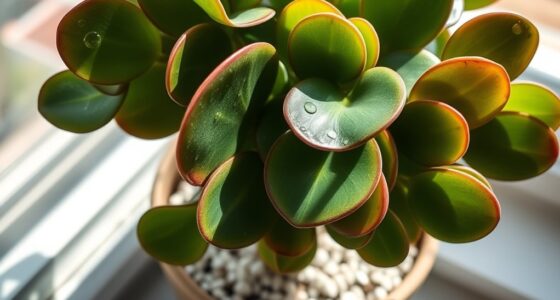To care for your snake plant, place it in bright, indirect light or tolerate lower levels, and introduce gradual direct sunlight to prevent leaf scorch. Water only when the top inch or two of soil dries out, typically every 2-6 weeks, and use well-draining soil to avoid root rot. Fertilize sparingly and keep leaves dust-free for healthy growth. Proper potting, maintenance, and troubleshooting tips can help your plant thrive—discover all the secrets in the full guide.
Key Takeaways
- Provide bright, indirect sunlight and gradually introduce direct sun to prevent leaf scorch.
- Water only when the top 3-4 inches of soil are dry, approximately every 2-6 weeks.
- Use well-draining soil and pots with drainage holes to prevent overwatering and root rot.
- Fertilize biannually with diluted 10-10-10 slow-release fertilizer during growing seasons.
- Regularly clean leaves, inspect for pests, and repot every 2-3 years to promote healthy growth.
Potting and Repotting Your Snake Plant

To keep your snake plant healthy and thriving, it’s important to choose the right potting method. When potting or repotting, select a container with drainage holes, like terracotta or clay, or drill holes if needed.
Use a well-draining soil mix, such as cactus or succulent soil with added Perlite, to prevent water retention and root rot.
Opt for cactus or succulent soil with Perlite to ensure proper drainage and prevent root rot.
When repotting, pick a container about 2 inches larger in diameter to allow room for growth without excess moisture.
Carefully remove the plant from its old pot, loosen tangled roots, and position it at the same soil level.
Repot your snake plant every 2-3 years or when it becomes root-bound, ensuring proper drainage and soil conditions for healthy development.
Optimal Lighting and Sunlight Conditions
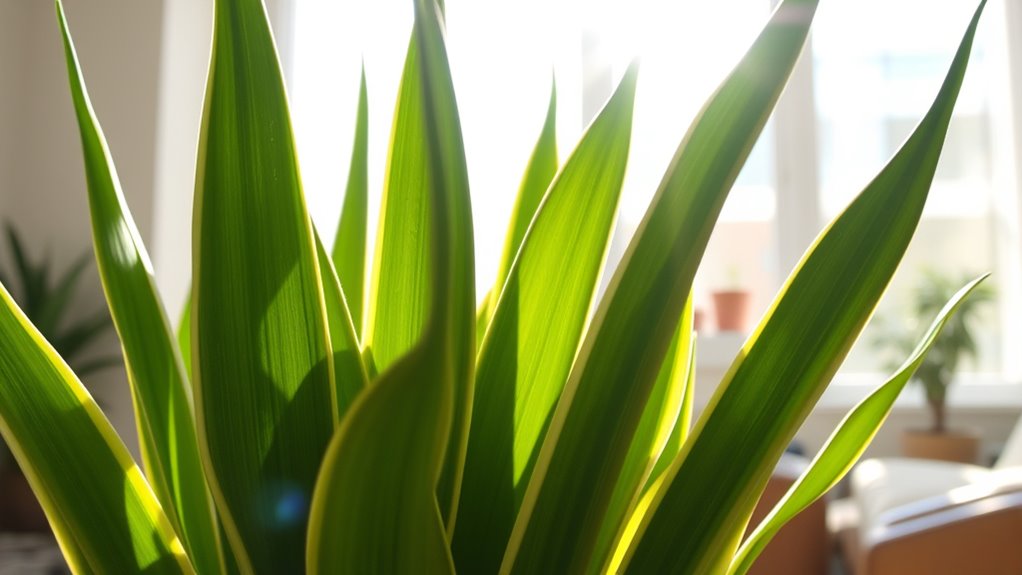
Snake plants do best in bright, indirect light but can handle lower light levels too. To encourage healthy growth and flowering, place yours near east-facing windows or spots with 8-10 hours of filtered sunlight. Be sure to gradually introduce direct sun to avoid leaf scorch and keep the leaves dust-free for ideal photosynthesis. Additionally, maintaining optimal color accuracy in your environment can help ensure the plant’s leaves retain their vibrant green color and overall health. As technology advances, automation in business can also be utilized to monitor and optimize light conditions for your plants. Incorporating AI-powered sensors can help you adjust lighting precisely, promoting healthier and more resilient snake plants. Recognizing light requirements is essential for maximizing the plant’s growth potential.
Light Preferences and Tolerance
Snake plants prefer bright, indirect light but can adapt to low light conditions, making them versatile for various indoor settings. They thrive with at least 8-10 hours of sunlight daily, especially near east- or south-facing windows. For ideal growth and flowering, you should acclimate your plant gradually to direct sunlight, starting with a few hours and increasing exposure slowly to prevent leaf scorch. While snake plants tolerate low light, insufficient sunlight can slow their growth and cause their leaves to lose vibrancy. To maximize light absorption, regularly clean the leaves to remove dust buildup, ensuring they can efficiently photosynthesize. Additionally, understanding indoor lighting conditions helps you maintain a healthy, resilient snake plant in your home. Proper lighting not only supports plant health but also enhances the plant’s overall appearance and vigor, especially when considering light preferences for optimal growth. Ensuring proper plant placement is also key to providing the best lighting conditions for your snake plant. Moreover, water management plays a role in maintaining healthy foliage by preventing overwatering in low-light environments.
Sunlight Duration and Placement
Ensuring your snake plant receives the right amount of sunlight is key to its health and growth. Ideally, it needs about 8 to 10 hours of indirect sunlight daily to grow best and maintain vibrant leaves. While it tolerates low light and can survive in dimly lit spaces or rooms without windows, growth slows under these lighting conditions. Proper placement is essential: near east-facing windows provides gentle morning light, perfect for healthy growth. Avoid sudden exposure to direct sunlight, which can scorch leaves. Adjusting sunlight duration gradually prevents stress. Use the table below to visualize lighting scenarios, and remember that understanding lighting requirements is essential for optimal plant care:
| Lighting Condition | Placement | Sunlight Duration |
|---|---|---|
| Bright, indirect | Near east-facing window | 8-10 hours |
| Low light | Dim corner or interior room | As much as possible, slow growth |
| Direct sunlight | Sunny balcony or south window | 1-2 hours, then shade |
| Fluorescent lighting | Office or basement | 10-12 hours |
Blooming and Light Needs
Wondering how to encourage your snake plant to bloom? Providing the right light needs is essential. Snake plants thrive with about 8 to 10 hours of indirect sunlight daily, which promotes healthy growth and flowering potential.
Bright, filtered light from east-facing windows or southern and western exposures helps support flowering, though indoor blooming remains rare. To prevent leaf scorch, gradually acclimate your plant to direct sunlight if moving it from shade or a shadier spot. Proper lighting boosts energy production, crucial for flowering, especially in cultivars known for blooming. Keep in mind that insufficient light or overly shaded conditions can slow growth and reduce flowering chances. Optimal lighting conditions are fundamental for encouraging your snake plant to bloom beautifully. Additionally, understanding light requirements can help optimize flowering success, especially since adequate light is necessary for flowering induction in snake plants.
Proper Watering and Humidity Practices
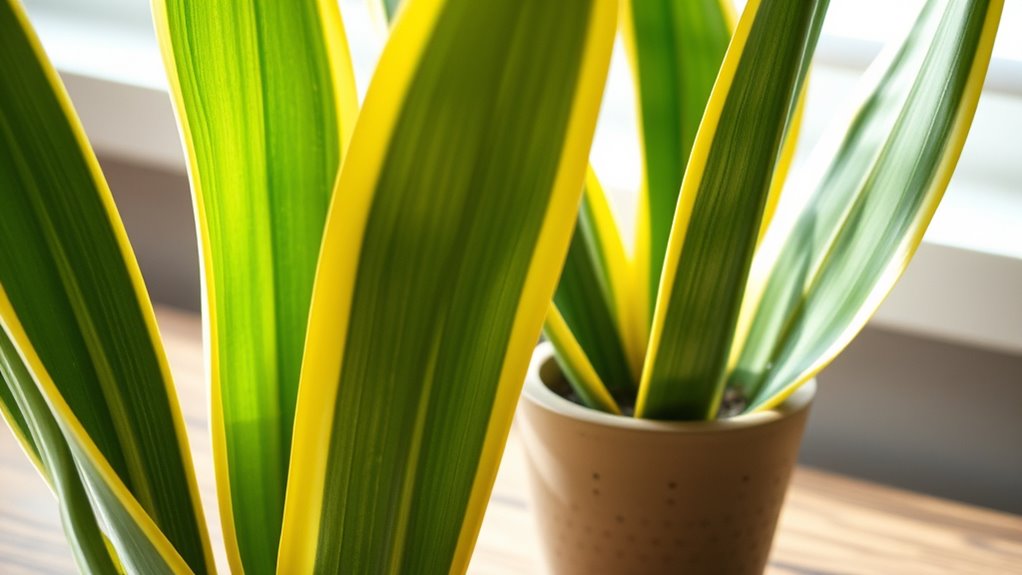
Proper watering is essential for snake plant health; it’s best to water only when the top 3-4 inches of soil are completely dry. This usually means watering every 2-6 weeks, depending on the season and environment. Use room temperature water and let tap water sit for 24 hours to reduce chemicals before watering. Overwatering can lead to root rot, yellowing leaves, and drooping, so guarantee your pot has good drainage and avoid letting the plant sit in excess water. During winter, cut back water frequency to about once a month, allowing the soil to fully dry between waterings. Snake plants tolerate low humidity, so maintaining indoor humidity levels between 30-50% is sufficient without misting. Proper watering practices are crucial for preventing common issues like root rot and ensuring your snake plant remains healthy. Adequate watering routines also help maintain optimal soil moisture levels, which are vital for the overall plant health and longevity of your snake plant. Ensuring proper watering and humidity practices keep your snake plant healthy and thriving.
Essential Fertilizing and Maintenance Tips
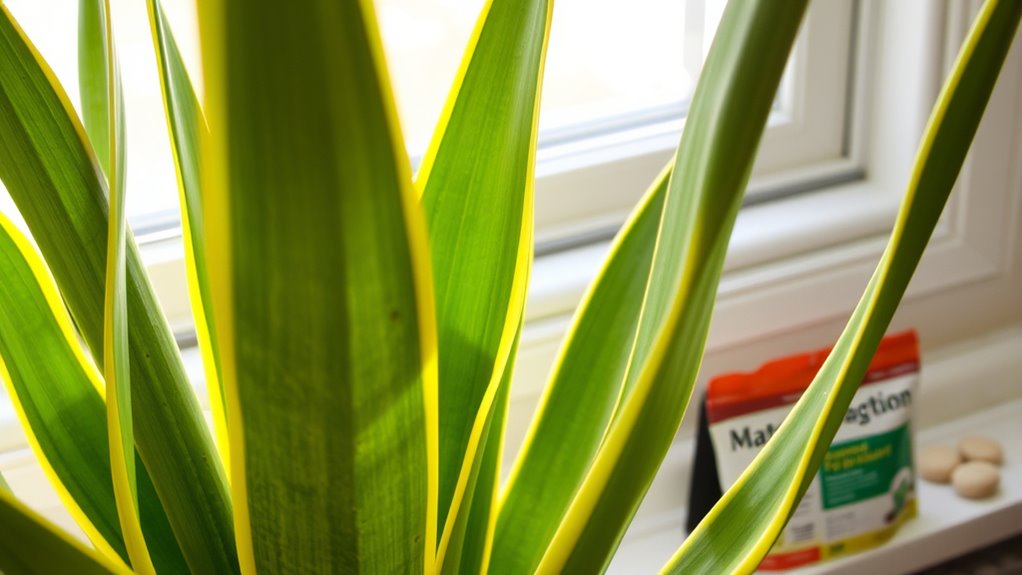
Fertilizing snake plants correctly and maintaining their overall health involves applying the right nutrients at the right times. Use a balanced 10-10-10 slow-release fertilizer twice a year, diluted to half strength during spring and mid-summer.
Apply a balanced 10-10-10 slow-release fertilizer twice a year for healthy snake plants.
Additionally, apply liquid fertilizer every six months, ensuring the soil is moist beforehand to prevent root burn. Proper maintenance includes regularly wiping the leaves with a damp cloth every few months to keep the foliage dust-free and promote photosynthesis.
Avoid fertilizing during fall and winter when growth slows down, to prevent overfeeding. Use organic or inorganic fertilizers suitable for indoor plants, but always follow the manufacturer’s instructions to avoid nutrient overload.
Proper fertilizing and maintenance support a healthy root system, vibrant leaves, and flourishing foliage.
Propagation Methods for Snake Plants
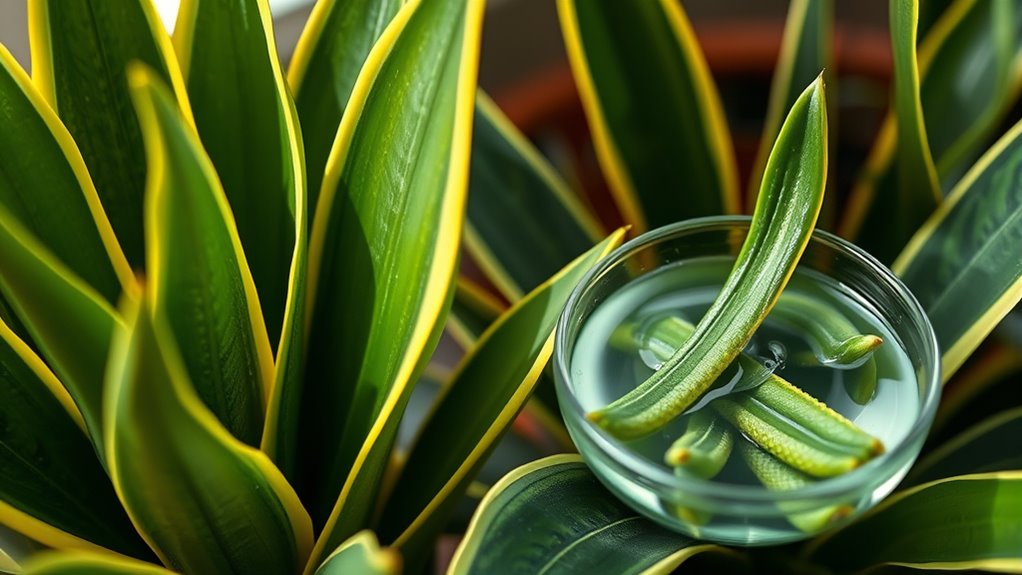
You can propagate snake plants by taking leaf cuttings, planting them in soil or water, and waiting for roots to develop.
When using water, keep the cut ends submerged and change the water regularly; roots usually appear within a couple of months.
Additionally, you can separate pups and offshoots from the main plant to grow new, independent plants.
Leaf Cutting Techniques
Propagating snake plants through leaf cuttings is an effective and straightforward method. Start by selecting healthy, mature leaves and use sterilized scissors to cut them into 4-6 inch sections. Allow the cuttings to callus over for 24-48 hours to prevent rot and encourage root development. Insert the callused end of each leaf segment into moist, well-draining soil or water, making sure at least one-third of the cutting is buried. Keep the soil consistently moist but not soggy, and position the cuttings in bright, indirect light to support root growth. Roots typically develop within 2-3 weeks in water or 1-2 months in soil. Once established, you can transplant your new snake plant into a suitable container for continued growth. Additionally, maintaining proper soil health helps promote healthy root development and overall plant vitality. Monitoring watering frequency is also essential to prevent overwatering and ensure successful propagation.
Water and Soil Propagation
Both water and soil methods offer effective ways to propagate snake plants, giving you options based on your preferences and resources.
For water propagation, you cut a healthy leaf at the base, place it in a glass with about 4 inches of water, and change the water regularly. Roots typically develop in several months, reaching 1-2 inches before you transfer the cutting to soil. Proper water quality and maintaining a clean container can help prevent rot and promote healthy root growth.
For soil propagation, allow cuttings to callus for a few days, then plant them in a well-draining soil mix, such as cactus or succulent mix. Keep the soil moist but not waterlogged to encourage roots without rot. Ensuring proper soil drainage is crucial to prevent overwatering and root rot.
Proper lighting and avoiding overwatering are essential in both methods to promote healthy root growth and successful propagation. Additionally, ensuring the plant receives adequate light exposure can significantly improve propagation success rates.
Propagating Pups and Offshoots
Snake plants naturally produce pups and offshoots from their rhizomes, offering easy ways to expand your collection. To propagate via pups or offshoots, follow these steps:
- Carefully remove the plant from its pot to access the root clumps.
- Gently tease apart pups or offshoots, ensuring each has enough roots and leaves. When separating, aim to minimize root damage to promote successful growth.
- Transplant them into containers with well-draining soil, promoting root development. Using a specialized cactus or succulent soil mix can improve drainage and prevent overwatering.
- Water lightly and place in bright, indirect light to encourage healthy growth. Proper watering and light conditions are crucial for establishing new plants.
You can also root offshoots in water by placing them in a jar until roots develop before transplanting into soil. Proper root separation helps ensure each new plant has a healthy start.
Proper root separation and transplanting during repotting help maintain vibrant, bushy snake plants. Maximize Space and Organization by creating designated zones for your plants, making maintenance easier and more efficient.
Common Problems and Troubleshooting Strategies
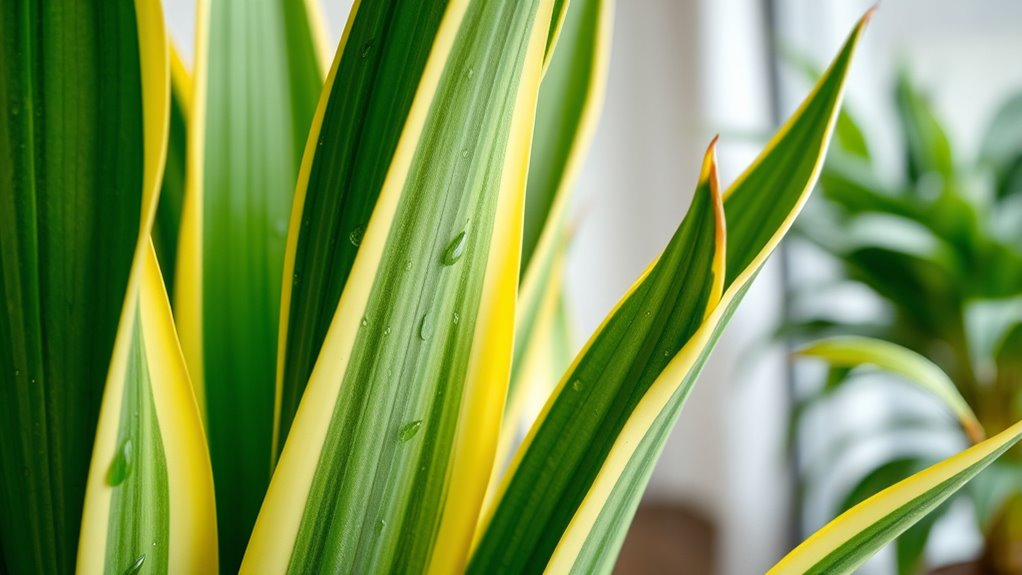
When caring for snake plants, it’s common to encounter issues that can affect their health and appearance. Yellowing leaves often signal overwatering, which can lead to root rot. Check the roots; if they’re brown or mushy, repot the plant in well-draining soil and trim affected roots.
Pests like spider mites, mealybugs, and scale insects can infest, so treat with neem oil, rubbing alcohol, or insecticidal soap.
Leaf curling or leaning might indicate low light or uneven watering—adjust placement and watering habits accordingly.
Brown tips or edges can be caused by low humidity, overexposure to direct sunlight, or salt buildup from fertilizers; cleaning leaves and improving watering can help.
Regular inspection prevents and addresses these common problems effectively.
Exploring Different Varieties and Aesthetic Options

Are you looking to add visual interest and variety to your plant collection? Exploring different snake plant varieties lets you create stunning, decorative displays. Here are some options to contemplate:
- The Whale Fin Sansevieria features large, dramatic, whale-shaped leaves, making a striking focal point.
- Sansevieria cylindrica, or Spike Plant, has sleek, cylindrical leaves that grow vertically, offering an architectural, modern look.
- The Sansevieria trifasciata ‘Twist’ showcases twisted, spiral-shaped leaves, adding a sculptural, unique element.
- Rhino Grass (Sansevieria desertii) has textured, grass-like leaves perfect for a lush, natural aesthetic.
These varieties, with their distinctive leaf patterns, enhance visual interest and bring decorative, sculptural appeal to your space.
Frequently Asked Questions
How Do You Care for a Sansevieria Snake Plant Indoors?
To care for your snake plant indoors, place it where it gets bright, indirect light, but it can handle lower light too.
Water only when the top 3-4 inches of soil are dry, usually every 2-4 weeks.
Use well-draining soil with drainage holes and keep the temperature between 55°F and 85°F.
Wipe the leaves regularly to remove dust and promote healthy growth.
What Makes a Snake Plant Happy?
You might think snake plants are low-maintenance, but they thrive when you give them what they love. Keep them in bright, indirect light, and don’t overwater—let the soil dry out completely between watering.
Use well-draining soil, maintain a warm temperature, and regularly check for pests. Clean their leaves, and they’ll stay happy, healthy, and grow beautifully.
Neglecting these cares can slow their growth or cause health issues.
Should You Water Sansevieria From Top or Bottom?
You should water your Sansevieria from the top. This method guarantees the soil is thoroughly soaked, promoting healthy root growth and preventing water from sitting on the leaves.
Be sure to allow excess water to drain out through the drainage holes. Bottom watering can cause uneven moisture and increase root rot risk.
Should I Cut the Brown off My Snake Plant?
Imagine a snake plant with golden-brown tips, like fading sunshine on its leaves. You should prune these brown areas to keep your plant looking vibrant and healthy.
Use sterilized scissors to make clean cuts, removing only the affected parts. This helps prevent pests and encourages new growth.
Conclusion
With a little care, your snake plant can thrive and brighten any space. Follow these tips, stay attentive to its needs, and you’ll see it flourish. Remember, patience is key—plants may not bloom overnight, but with consistent love, they’ll reward you in their own time. Keep nurturing your green companion, and soon you’ll find yourself in a lush oasis that’s worth its weight in gold. Your efforts will truly pay off!


